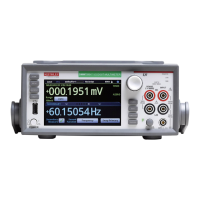7½ Digit Graphical Sampling Multimeter Reference Manual Section 3:
DMM7510-901-01 Rev. B / May 2015 3-15
The System Events tab on the System Event Log menu (on page 2-49) displays the following buffer
events:
• Event code 4915, "Attempting to store past the capacity of reading buffer," which occurs when a
buffer that is set to fill once is full.
• Event code 4916, "The fill status of bufferVar is 0% filled."
Event code 4917, "Reading buffer bufferVar is 100% filled."
Timestamps
The measurements in the reading buffers contain timestamps. Readings start at the first entry in the
empty reading buffer. Readings are then taken sequentially until the end of the buffer is reached. If
the buffer fill mode is continuous, readings wrap to the first entry and fill again. The relative time is
taken from the first reading made after a buffer is cleared.
For a buffer that fills once, the first entry has a time of 0. For continuous buffers, the lowest timestamp
is after the last entry. For example, if you take 150 readings into a buffer with a capacity of 100, the
last reading is at entry 50 and the earliest reading is at 151.
The buffer style you select when creating a buffer affects the resolution of the timestamp. For the
compact buffer style, the timestamp is a 1 µs accuracy relative timestamp with a one-hour time span
before the timestamp starts over. For Standard and Full buffer styles, the timestamp is absolute; full
date and time is recorded.
Creating buffers
To create a new user-defined reading buffer, you need to provide a name, capacity, and style for the
new buffer.
User-defined buffer names must start with an alphabetic character. The names cannot contain any
periods or the underscore (_) character. The name can be up to 32 characters long.
There is no fixed limit on the number of user-defined reading buffers you can create. However, you
are limited by available memory in the instrument. The overall capacity of all buffers stored in the
instrument cannot exceed 11,000,000 readings for standard reading buffers and 27,500,000 for
compact reading buffers.
When you create a reading buffer, it becomes the active buffer. If you create two reading buffers, the
last one you create becomes the active buffer.
The following topics provide information about using the front panel to create buffers and introduce
how to use remote commands to create buffers.
For additional information about using remote commands for buffer operations, see the following
sections of this manual:
• Remote buffer operation (on page 3-30)
• SCPI commands, see TRACe subsystem (on page 6-151)
• TSP commands, see TSP commands (on page 8-7)

